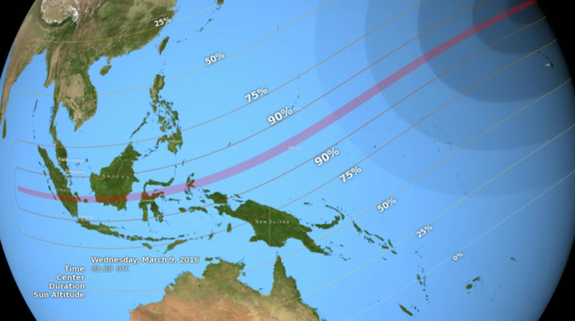Editor’s note for March 8, 10:45 pm ET: The total solar eclipse of 2016 has ended. You can see photos of the solar eclipse here . To see our full wrap up, read: Total Solar Eclipse Wows Skywatchers Across Indonesia, Pacific Region .
When the sun goes dark, NASA’s work is just beginning.
Space.com talked with NASA sun expert C. Alex Young to learn just what research will get done during the roughly 4 minutes the sun hides fully behind the moon during today’s solar eclipse, which is the only total eclipse of the sun in 2016 , from NASA’s observing location on Woleai Island in Micronesia, where it will be daytime Wednesday local time during the eclipse. Young described exactly what NASA is looking for during today’s event in a video interview on the total solar eclipse .
According to Young, NASA researchers have set up equipment in the path of the solar eclipse poised to examine the sun’s outer atmosphere, called its corona, which is normally about a million times dimmer than the solar disc.
“This particular part of the solar atmosphere is really critical because it’s where all the action is happening,” Young told Space.com. “It’s where solar eruptions, solar flares, coronal mass ejections and all the different parts that make up solar weather are originating from.”

This NASA graphic shows the visibility ranges for the total solar eclipse of 2016 over parts of southeast Asia on March 9, 2016. The red bar in the center denotes the path of totality, where the full eclipse is visible.
Credit: NASA/Goddard Space Flight Center Scientific Visualization Studio
Credit: Karl Tate, SPACE.com Contributor
The corona can be seen only from the ground during this kind of total solar eclipse . And tonight’s event, the only total solar eclipse of 2016, will serve as good practice for August 2017, when the “Great American Eclipse ” — an extremely rare total solar eclipse that travels across the continental United States — will occur.
“We’re all really, really excited about that and looking forward to it,” Young said. “It’s going to be starting in Oregon, traveling down across the U.S. and then ending in South Carolina. At any one place, you’re going to have roughly two and a half minutes of totality, but because it’s traveling across the entire U.S., we’re lining up instrumentation, identical instrumentation all along the path, which is basically allowing us to observe the eclipse over a period of hours, as opposed to a period of minutes.”
So, what might you see if you’re in the path of tonight’s total solar eclipse, or the Great American Eclipse of 2017?
“There’s a lot of things that are really going to be amazing,” Young said. “They [viewers] are going to be able to see this wispy structure where you actually have magnetic fields coming out of the sun, creating streams of solar plasma.”
“You’ll experience total darkness; you can see stars,” he added. “And also, because it’s totally dark, you’ll feel the temperature drop, and as well animals will think it’s nighttime — all of a sudden, sudden quietness coming from animals.”
Credit: Karl Tate, SPACE.com Contributor
If you’re not along the path of this eclipse, visible from Indonesia or the North Pacific Ocean, you can watch a live webcast by the online Slooh Community Observatory starting at 6 p.m. EST (2300 GMT). You can go to Slooh.com to join and watch the live broadcast, snap and share your own photos during the event, chat with audience members and interact with the hosts, and personally control Slooh’s telescopes — totality from Slooh’s location will occur around 7:37 p.m. EST (0037 on March 9 GMT). You can also watch the solar eclipse webcast on Space.com , courtesy of Slooh.
NASA will also host its own webcast on NASA TV from a different location starting at 8 p.m. EST (0100 GMT on March 9).
Editor’s note: If you safely capture an amazing photo of today’s total solar eclipse and would like to share it with us and our news partners for a story or gallery, send images and comments in to Managing Editor Tariq Malik at spacephotos@space.com. You should NEVER look at the sun through a telescope, binoculars or unaided eyes without proper safety equipment. Serious eye injury can result. Scientists and solar observers use special filters to safely observe the sun.
Email Sarah Lewin at slewin@space.com or follow her @SarahExplains . Follow us @Spacedotcom , Facebook and Google+ . Original article on Space.com .

Comments are closed.